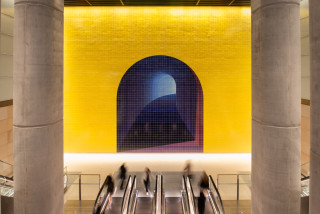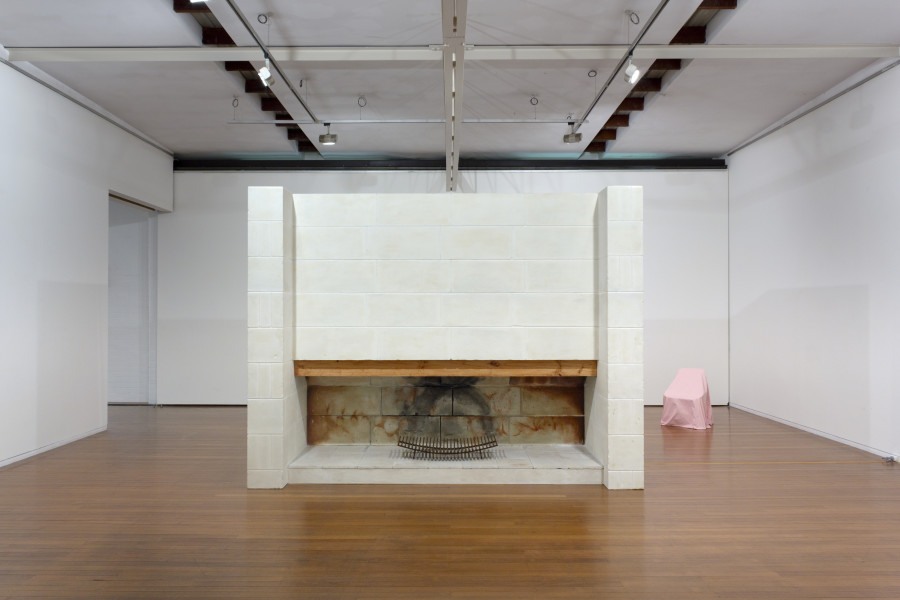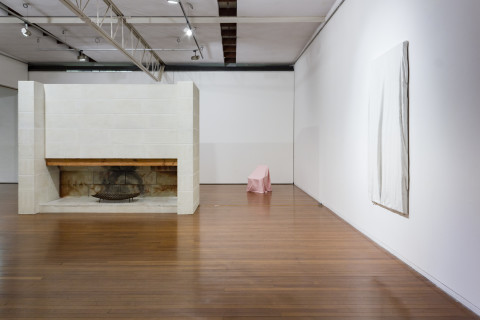Fittingly, the raison d'être of theatre design is the mimicry of interiors, a kind of mise-en-scène in Morton’s investigation of the insides.
Exhibition Dates: 23 June – 21 July 2012
Roslyn Oxley9 Gallery is pleased to present a major solo exhibition by Callum Morton. ‘The Insides’ begins outside with an immigration shop-front awning and a wall that obstructs entry to the gallery. The affronting water-stained barrier also acts a concealed entrance – a corridor that leads, inevitably, to an interior.
Inside, a reconstructed Modernist fireplace rumbles hungrily. One to one is a replica of the1960s fireplace designed for John and Sunday Reed’s Modernist home at Heide in Melbourne. If a hearth is a home’s heart, the core of this interior has been plucked out and re-located. Decontextualized, the structure's abstract lines and volumes visually dominant and the connotations of warmth and conversation traditionally associated with a fireplace seem faint and distant. Instead the large slabs of stone evoke a memorial-like structure such as a tomb or sarcophagus. Emerging from the guts of the hearth are gurgling sounds reminiscent of digestion. These internal noises enliven the ghostly structure, while also echoing its original function of consumption.
Opposite the fireplace, on the reverse of Morton’s entry wall, geometric blocks of colour describe another interior – the theatre. In the tradition of Le Corbusier’s internal murals, Morton has painted the proscenium of an early experimental theatre set. Fittingly, the raison d'être of theatre design is the mimicry of interiors, a kind of mise-en-scène in Morton’s investigation of the insides.
Two other objects inhabit Morton’s interior – a shrouded de Kooning-scaled painting and a cloaked Eames chair. These sculptures are replicas of camouflaged objects that have been created using CNC technology. They speak of absence or abandonment, of vacated interiors, or simply unfashionable items collecting dust in a museum’s storehouse. Yet the act of concealment makes them exciting. These objects are energised by what is invisible, by the idea of hidden content. Together, Morton’s sculptures provide an eerie sense of secret lives of things.
—
Callum Morton is one of Australia’s leading contemporary artists. He represented Australia at the 52nd Venice Biennale (2007) with the monumental outdoor sculpture, Valhalla. Morton was selected for the Scape Biennial (Christchurch) in 2008, the Busan Biennale in 2006 and the Indian Triennial in 2004. Other important group shows include: Forever Young: 30 Years of the Heide Collection, Heide Museum of Modern Art, Melbourne; Adelaide Biennale, Before and After Science, curated by Charlotte Day and Sarah Tutton, Art Gallery of South Australia, Adelaide; The Dwelling, ACCA, Melbourne; Lost and Found: An Archeology of the Present, TarraWarra Biennial, Melbourne; DeOverkant/Downunder, Den Haag Sculpture 2007, Netherlands; High Tide: Currents in Contemporary Australian Art, Zacheta National Gallery of Art, Warsaw and the Contemporary Art Centre, Vilnius (2006); the 2nd Istanbul Pedestrians Exhibition (2005); the 2nd Auckland Triennial (2004); Face Up: Contemporary Art from Australia, Hamburger Bahnhof, Berlin (2003). Solo museum exhibitions include Babylonia at the Australian Centre for Contemporary Art, Melbourne (2005), More Talk about Buildings and Mood at the Museum of Contemporary Art, Sydney (2003) and International Style at the Santa Monica Museum of Art, Los Angeles (1999). In 2008. Morton completed a major commission, Hotel, 2008 for the Eastlink freeway (Nunawading to Frankston, Melbourne). The following year Morton completed Grotto, an important commission for the Fundament Foundation, Netherlands. He has been exhibiting with Roslyn Oxley9 Gallery since 1998.

resin, sand, polystyrene, synthetic polymer paint, timber
290 x 400 x 30 cm

polystyrene, epoxy resin, steel, sand, wood, synthetic polymer paint, light, CD, audio unit
256 x 335 x 132 cm
 Callum Morton The Underneath
Callum Morton The Underneath
Gadigal Station Sydney Metro, Sydney, 2024
 Callum Morton In Through The Out Door
Callum Morton In Through The Out Door
Market Row and Mullins Street, Sydney, 2024
 Group Show, What Does the Jukebox Dream Of?
Group Show, What Does the Jukebox Dream Of?
Art Gallery of New South Wales, 2024
 Group Show, The First 40 Years
Group Show, The First 40 Years
Roslyn Oxley9 Gallery, 2024
 Group Show, nightshifts
Group Show, nightshifts
Buxton Contemporary, 2023
 Callum Morton View from a Bridge
Callum Morton View from a Bridge
Roslyn Oxley9 Gallery, 2020
 Group Show, State of Play
Group Show, State of Play
Roslyn Oxley9 Gallery, 2017
 Group Show
Group Show
Roslyn Oxley9 Gallery, 2016
 Group Show, Solid State
Group Show, Solid State
Casula Powerhouse, 2015
 Callum Morton Monument Park
Callum Morton Monument Park
New Quay, Docklands, Melbourne, 2015
 Callum Morton The Other Side
Callum Morton The Other Side
19th Biennale of Sydney, 2014
 Callum Morton The Insides
Callum Morton The Insides
Roslyn Oxley9 Gallery, 2012
 Mikala Dwyer Before and After Science
Mikala Dwyer Before and After Science
Adelaide Biennial of Australian Art, 2010
Group Show, Grotto
The Fundament Foundation, Tilburg, The Netherlands, 2009
 Callum Morton Wall to Wall
Callum Morton Wall to Wall
Roslyn Oxley9 Gallery, 2009
Callum Morton SCAPE
Christchurch Biennial, 2009
Callum Morton Hotel
Eastlink Freeway, Melbourne, 2008
 Group Show, Summer '07 '08
Group Show, Summer '07 '08
Roslyn Oxley9 Gallery, 2007
 Callum Morton Valhalla
Callum Morton Valhalla
52nd Venice Biennale, 2007
 Callum Morton Piles, Pools and Projections
Callum Morton Piles, Pools and Projections
Roslyn Oxley9 Gallery, 2006
 Group Show
Group Show
Roslyn Oxley9 Gallery, 2005
 Group Show, If these walls could talk
Group Show, If these walls could talk
Roslyn Oxley9 Gallery, 2005
Callum Morton Babylonia
Australian Centre for Contemporary Art, Melbourne, 2005
Callum Morton Tomorrow Land
Chandigarh Museum and Art Gallery, India, 2004
Callum Morton Stonewash
Istanbul Pedestrian Exhibition 2: Tunel-Karakoy, Turkey, 2004
Callum Morton Habitat
National Gallery of Victoria, Melbourne, 2003
Group Show, LOCAL +/OR GENERAL
New Canaan, Connecticut, 2003
 Group Show, The First 20 Years
Group Show, The First 20 Years
Roslyn Oxley9 Gallery, 2002
Group Show, Bittersweet
Art Gallery of New South Wales, Sydney, 2002
 Callum Morton LOCAL +/OR GENERAL
Callum Morton LOCAL +/OR GENERAL
Roslyn Oxley9 Gallery, 2001
 Callum Morton Don't Even Ask
Callum Morton Don't Even Ask
Roslyn Oxley9 Gallery, 2000
 Callum Morton International Style
Callum Morton International Style
Roslyn Oxley9 Gallery, 1999
 Group Show, Every other day
Group Show, Every other day
Roslyn Oxley9 Gallery, 1998
Callum Morton Cellar
First Floor, Melbourne, 1998
Callum Morton Now & Then
Govett-Brewster Art Gallery, New Zealand, 1997









